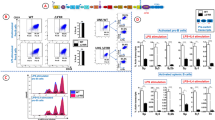Abstract
THE immunoglobulins of mice and other animals consist of several distinct heavy chains associated with either of two light chains (κ or λ). Adult animals of different species produce immunoglobulins which demonstrate widely divergent ratios of κ to λ light chains. In mice, most of B-cell surface immunoglobulins possess κ light chains1. However, as all previous work on the ratio of κ/λ immunoglobulins was based on experiments with adult animals, the possibility that immature populations of B cells may demonstrate a more evenly balanced ratio of κ to λ positive cells was investigated. In this study, populations of cells known to contain immature B lymphocytes were examined by indirect immunofluorescence for the presence of κ and λ positive cells. The results demonstrate that fetal liver, bone marrow and spleens from young mice contain B cell populations with a κ/λ ratio approaching unity. In the spleen, the κ/λ ratio increased as a function of age with the most dramatic shift occurring between 4 and 6 weeks of age. A similar, but less dramatic increase in the κ/λ ratio occurs in the bone marrow. Based on these data, we propose that the final predominance of κ-bearing cells is based on a two-stage process. Initially, there is an equal probability of κ or lambda; light chain expression at the cell surface. However, the κ-bearing cells, which possess a more abundant repertoire of Vκ genes, eventually predominate as a result of antigen driven clonal expansion.
This is a preview of subscription content, access via your institution
Access options
Subscribe to this journal
Receive 51 print issues and online access
$199.00 per year
only $3.90 per issue
Buy this article
- Purchase on Springer Link
- Instant access to full article PDF
Prices may be subject to local taxes which are calculated during checkout
Similar content being viewed by others
References
Hood, L., Gray, W. R., Sanders, B. G. & Dreyer, W. J. Cold Spring Harb. Symp. quant. Biol. 32, 133 (1967).
Bevan, M. J., Parkhouse, R. M. E., Williamson, A. R. & Askonas, B. Prog. Biophys. molec. Biol. 25, 209 (1972).
Koshland, M. E. Cold Spring Harb. Symp. quant. Biol. 32, 119 (1967).
Milstein, C. & Pink, J. R. L. Prog. Biophys. molec. Biol. 21, 209 (1970).
Putnam, F. Science 163, 633 (1969).
Todd, C. & Inmann, J. Immunochem. 14, 407 (1967).
Wang, A. C., Wilson, S. K., Hopper, J. E., Fudenberg, H. H. & Nisonoff, A. Proc. natn. Acad. Sci. U.S.A. 66, 337 (1970).
Feinstein, A. Nature 199, 1197 (1963).
Kindt, T. J. & Todd, C. W. J. exp. Med. 130, 859 (1969).
Herzenberg, L. A. Cold Spring Harb. Symp. quant. Biol. 29, 455 (1964).
Lieberman, R. & Potter, M. J. molec. Biol. 18, 516 (1966).
Potter, M. & Lieberman, R. Cold Spring Harb. Symp. quant. Biol. 32, 187 (1967).
Potter, M. & Lieberman, R. Adv. Immun. 7, 91 (1967).
Kohler, H., Shimizo, H. A., Paul, C., Moore, V. & Putman, F. W. Nature 227, 1318 (1970).
Hood, L. & Ein, D. Nature 220, 764 (1968).
Potter, M. Physiol. Rev. 52, 631 (1972).
McIntire, K. R. & Rouse, A. M. Fedn Proc. 29, 704 (1970).
Barandun, S., Skvaril, F. & Morell, A. Clin. Immun. 3, 57 (1977).
Spear, P. G., Wang, A., Rutishauser, U. & Edelman, G. J. exp. Med. 138, 557 (1973).
Lynes, M. A., Lanier, L. L., Babcock, G. F., Wettstein, P. J. & Haughton, G. J. Immun. (in the press).
Lanier, L. L., Lynes, M., Haughton, G. & Wettstein, P. J. Nature 271, 554 (1978).
Pernis, B., Forni, L. & Amante, A. L. J. exp. Med. 132, 1001 (1970).
Babcock, G. F., Lanier, L. L., Lynes, M. A. & Haughton, G. J. Immuno. Meth. (in the press).
Snedecor, G. W. & Cochran, W. G. Statistical Methods 6th edn, ch. 10 (Iowa State Univ. Press, 1967).
Jonckhecre, A. R. Biometrika 41, 133 (1954).
Author information
Authors and Affiliations
Rights and permissions
About this article
Cite this article
HAUGHTON, G., LANIER, L. & BABCOCK, G. The murine kappa light chain shift. Nature 275, 154–157 (1978). https://doi.org/10.1038/275154a0
Received:
Accepted:
Published:
Issue Date:
DOI: https://doi.org/10.1038/275154a0
This article is cited by
-
A primer set for the rapid isolation of scFv fragments against cell surface antigens from immunised rats
Scientific Reports (2020)
-
Genetic removal of the CH1 exon leads to the production of hypofunctional heavy chain-only IgG2a in rats
Transgenic Research (2020)
Comments
By submitting a comment you agree to abide by our Terms and Community Guidelines. If you find something abusive or that does not comply with our terms or guidelines please flag it as inappropriate.



